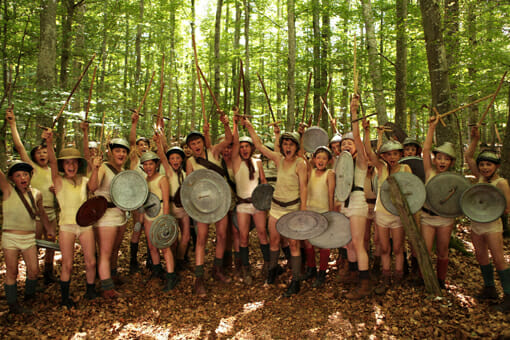By Pam Glazier · July 23, 2012

OK guys, somewhere in here, amid all my complaining, is a pertinent writing lesson. So slog through because it should be worth it in the end and you’ll make better movies for having read it.
The War of the Buttons, a new French period film released this week, tells the story of a group of young boys growing up in a rural village in occupied France during World War II. The actors were good, the cinematography picturesque, but the story didn’t bind me deeply. There was a little too much sappiness, and when there did happen to be some decent conflict it was soon dropped without resolution—which of course was blandly dissatisfying. And beyond that was the awful score. It was the same rip-off score that all these “magic of youth” pictures have, with flourishing wind sections to hint at a child’s revelry in the splendor of the everyday and simple. It sounded as if the scores to Hook and Jurassic Park had a maddeningly sappy child. This film is an optimist’s version of a holocaust movie for the family set. The film was an amalgam of My Girl, The Sand Lot, and Stand By Me, but most of its poignancy was sucked out and then it was fortified with a light peppering of Nazis.
The main kid, Lebrac (Jean Texier) gave a pretty good performance. And L’instituteur (Guillaume Canet)—that’s French for “teacher”—was also quite nice. But there was an overabundance of cuteness amidst all the other kid characters that seems to come standard with these types of nostalgia films. But all this cuteness overshadowed some of the cooler moments of the film. Lebrac is a dumb son of a farmer. He’s angry and stupid, yet somehow the kids look up to him. And because he’s in the middle of a “gang war” (it’s the cutest gang war you’ve ever seen) with the kids from the neighboring village, he takes an interest in the tactics of ancient wars. This is bolstered when the cute new girl lends him a history book on the Prussian wars. The “gang war” heats up and comes to a head, but before any satisfying build up and resolution can happen, we instead switch tracks and have the whiney fat kid narc on the town’s Jew-in-hiding and on the people helping to hide her. So now we’re stuck in a crappier rendition of the ending of The Sound of Music. And of course the neighboring enemy kids chip in to help save her.
There were a lot of things that were great in this movie—Lebrac’s blossoming love for the new girl, his sudden willingness to learn, his attempts to understand his father—but there was this ridiculous “war of the buttons” (the dumb cute gang war) that kept getting in the way. I suppose there had to be a reason to get all these characters together so we could watch them, and this seems as good a reason as any, but I kept getting distracted by all the heavy handed metaphors smacking me in the face every five minutes. Yes, kids fighting over buttons is ridiculous, just as WWII was ridiculous. Yes, sometimes violence is pointless and goes too far, please, show me a representation of this using low stakes and play-fighting children. Yes, Nazi’s are all just scared little boys hiding behind a uniform, let’s go so far as to show this as blatantly as possible since we’ve used up all our metaphor allotment by this point in the film.
See, I told you there was a lot of complaining. But the main point, the reason this film deflated, was because the two storylines each seemed to resolve on their own and when they finally did meet, they didn’t intersect right. You see, nowadays there’s all these fancy story line architectures that are intricate and interweave and whatnot. You can see fancy printed diagrams of them all in screenwriting books. There’s dovetailing, backtracking, paralleling, and any number of other styles of laying out a narrative. And as confusing as all that must be, let me just tell you: if you are using more than one story arc in a movie, the main plot points still have to be relatively close to each other in regards to when they happen in the film, and they have to be similar in intensity. The film Crash does this really well by matching the two highest points of two or more separate story arcs at the same instant (the locksmith’s daughter protecting him from the distraught store owner, the non-racist cop getting spooked at the wrong time by a “thug” type, etc). Both of those scenes required the buildup of two completely separate arc, but when they intersected, the effect was explosively impactful because when you multiply a finale by 2, it’s a double-whammy. Unfortunately, The War of the Buttons fails in this because a lot of the conflict is deflated before it can build, and so when the two worlds meet, no one cares.
So there you go kids. If you’re going to go for all the high-falutin’ story architecture, make sure your fundamentals are still in place—plot points, sequences, character arcs, etc.—and once that’s done, make sure you don’t deflate your conflict in one story line before it has a chance to double its impact through interaction with another, for that makes any furtherance of that plot irrelevant and boring.
Also, the only reason you should go out to see this is if you are being forced to take your Francophile grandparents out to the movies, otherwise skip it or wait for cable.